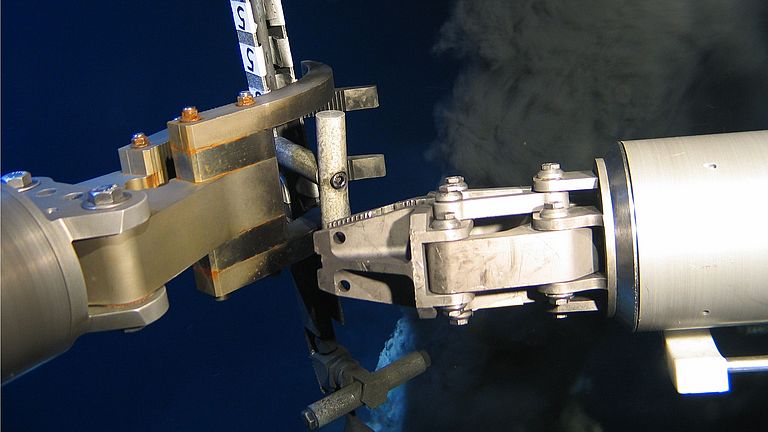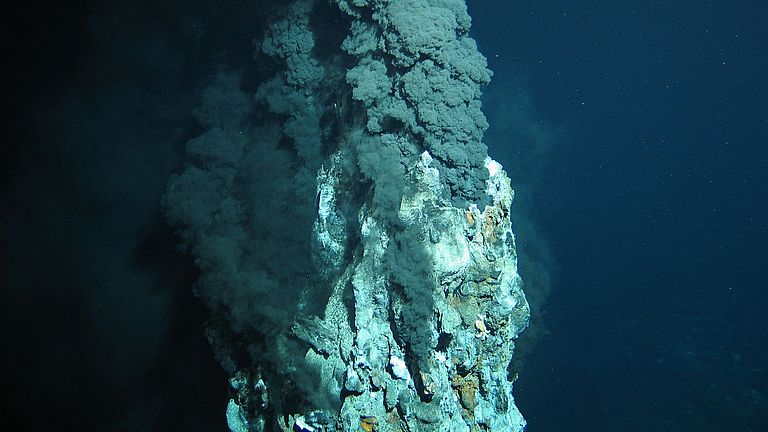Exploring Inhospitable Depths
Expedition starts to unveil Red Sea's Hydrothermal Vents
The vibrant reefs that line the shores of the Red Sea, well known to tourists and divers alike, belie the fact that this marine environment is one of the harshest on the planet. With high seawater salinity and temperatures that never drop below 20°C, even at its deepest points, the Red Sea is ten times warmer than most other deep oceans. In addition, the Red Sea underwent massive changes during the last glacial maximum just 20 000 years ago, causing a major extinction of species, and much of the deep-sea life is still recovering. As such, the deep Red Sea is an ideal location and a natural laboratory to study how life evolves and thrives under extreme conditions, which may shed light on the early evolution of life on Earth. Scientists from GEOMAR Helmholtz Centre for Ocean Research Kiel and KAUST King Abdullah University of Science and Technology will study the geological system and the evolution of hydrothermal ecosystems in one of the Earth's youngest oceans.
Expedition M194 on the R/V Meteor - an icon of the German research fleet - will depart from the port of Jeddah, Saudi Arabia, and take the scientific team to the Rift Valley in the middle of the Red Sea. At this active plate boundary between Africa and Arabia, the two continents are separating at a rate of 10-16 mm per year, causing volcanic activity. There, the scientists will be looking for hydrothermal vents.
"The Red Sea is a young ocean basin with an unexplored, volcanically active rift axis of almost 2,000 km. We expect many undiscovered vent sites," says the expedition's chief scientist, Dr Nico Augustin, marine geologist at the GEOMAR Helmholtz Centre for Ocean Research Kiel, Germany. In addition to studying the geological aspects of hydrothermal systems in the Red Sea, there is a big question to be answered about what faunal communities might have evolved around the Red Sea vents, adds co-chief scientist Prof. Froukje van der Zwan from KAUST: "Because of the unique environmental conditions, we have no idea what possible vent communities in the Red Sea look like. Are they comparable or completely different to what we know from other oceans?”
The Red Sea is famous in the geological and biological sciences for its hostile, hyper-saline underwater lakes known as brine pools. Some are as hot as 70°C and contain metalliferous mud, a sign of high-temperature hydrothermal activity. The sources have never been located or explored because even the most advanced robotic equipment cannot enter a hot brine without risking serious damage. However, as the brines cover only a tiny fraction of the so-called neo-volcanic zone in the rift, the M194 HEXPLORES (Hydrothermal Exploration of the Red Sea) expedition will concentrate on the rest of the rift axis, which is accessible with modern seafloor observation systems.
The main instrument will be the ROV Kiel 6000, a remotely operated diving-robot with lights, cameras and grabs that will be the eyes and hands on the seafloor. In addition, the scientists plan to use a towed video observation system and water column sensors to locate the vents. Once located, the sites will be mapped and documented in great detail to study the unique hydrothermal habitats and the tectonic and magmatic processes that led to their formation. “For the first time, we will be able to collect discrete, high-quality fluid samples from these unique systems, using the capabilities of the ROV Kiel 6000. This information is essential to understand the underlying geological processes and the ecosystem associated with the hydrothermal activity”, says Prof. Sylvia Sander, head of the Marine Mineral Resources Group at GEOMAR.
Several previous expeditions by GEOMAR and KAUST have provided the framework for this joint cruise by collecting valuable data on the geology of the Red Sea, and the scientists involved hope that the expedition, which has been planned for almost ten years, will finally pinpoint the active vents in the rift. The 27 participants from 10 different countries include researchers from the Saudi National Center of Wildlife (NCW), the British Antarctic Survey (BAS), and the Universities of Ottawa, Canada, and Macau, China.
Expedition at a glance:
Name: METEOR 194 (M194), HEXPLORES (Hydrothermal EXPLOration of the REd Sea)
Chief Scientists: Dr Nico Augustin (GEOMAR), Prof Froukje van der Zwan (KAUST)
Start: 10 October 2023, Jeddah (Saudi Arabia)
End: 7 November 2023, Piraeus (Greece)

"Eyes and hands on the seabed": The ROV KIEL 6000 enables work near black smokers like here in the area of the Mid-Atlantic Ridge. Photo: ROV team / GEOMAR

On the seabed, at a depth of several thousand metres, black smokers transport valuable raw materials up from the earth's interior. They got their name because of their resemblance to industrial chimneys. Photo: GEOMAR

The research vessel METEOR takes the team of 27 scientists to the rift valley in the middle of the Red Sea. Photo: Holger von Neuhoff / GEOMAR
![[Translate to English:] Ein gelber Tauchroboter taucht in blaues Wasser](/fileadmin/_processed_/d/f/csm_2013-12-13_ROV-KIEL-6000_01_ROV-Team_180440e87a.jpg)
Das ROV KIEL 6000 ist ein „Remotely Operated Vehicle“, ein ferngesteuertes Unterwasserfahrzeug, das mit Scheinwerfern, Kameras, Sensoren und Greifwerkzeugen ausgestattet ist. Diese Tauchroboter werden über ein Kabel von einer Steuerungseinheit auf dem Schiff aus bedient. Foto: ROV-Team / GEOMAR


